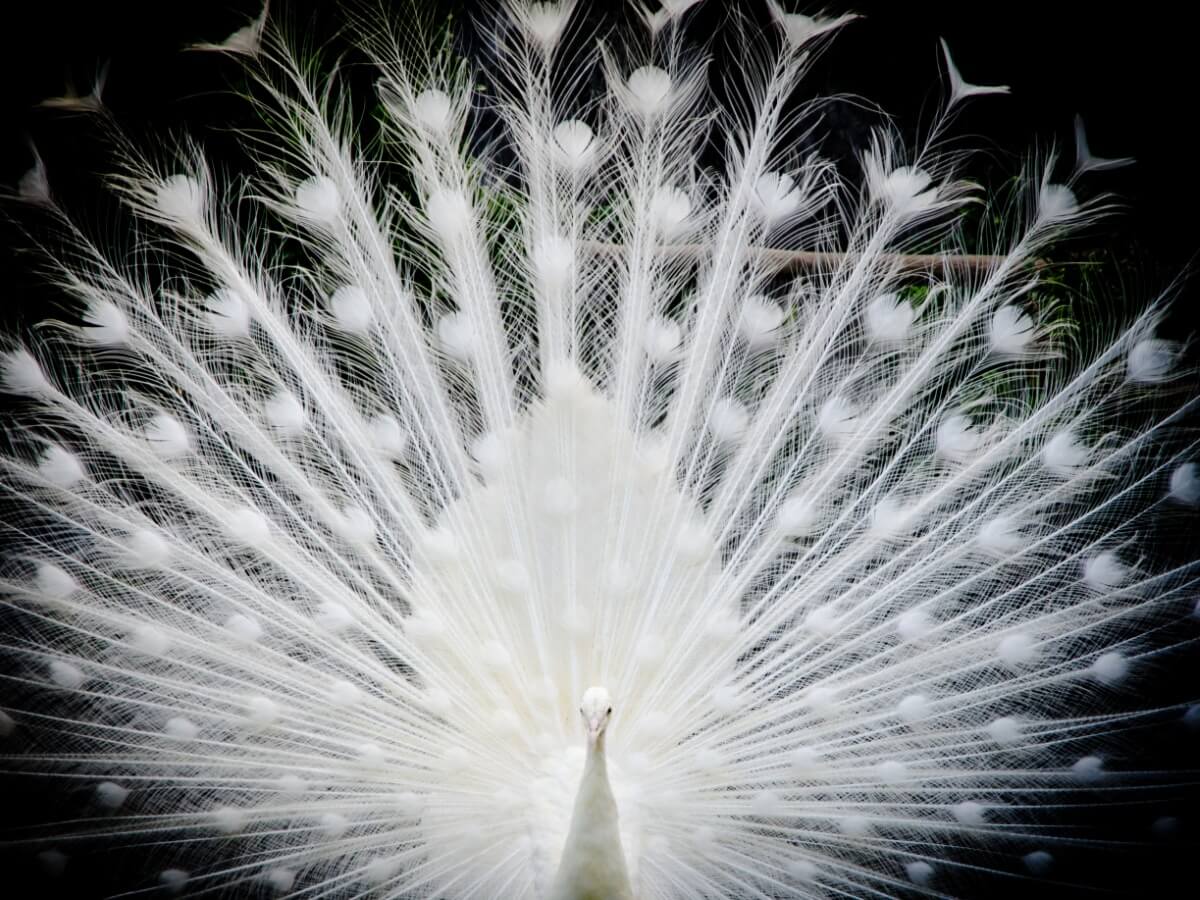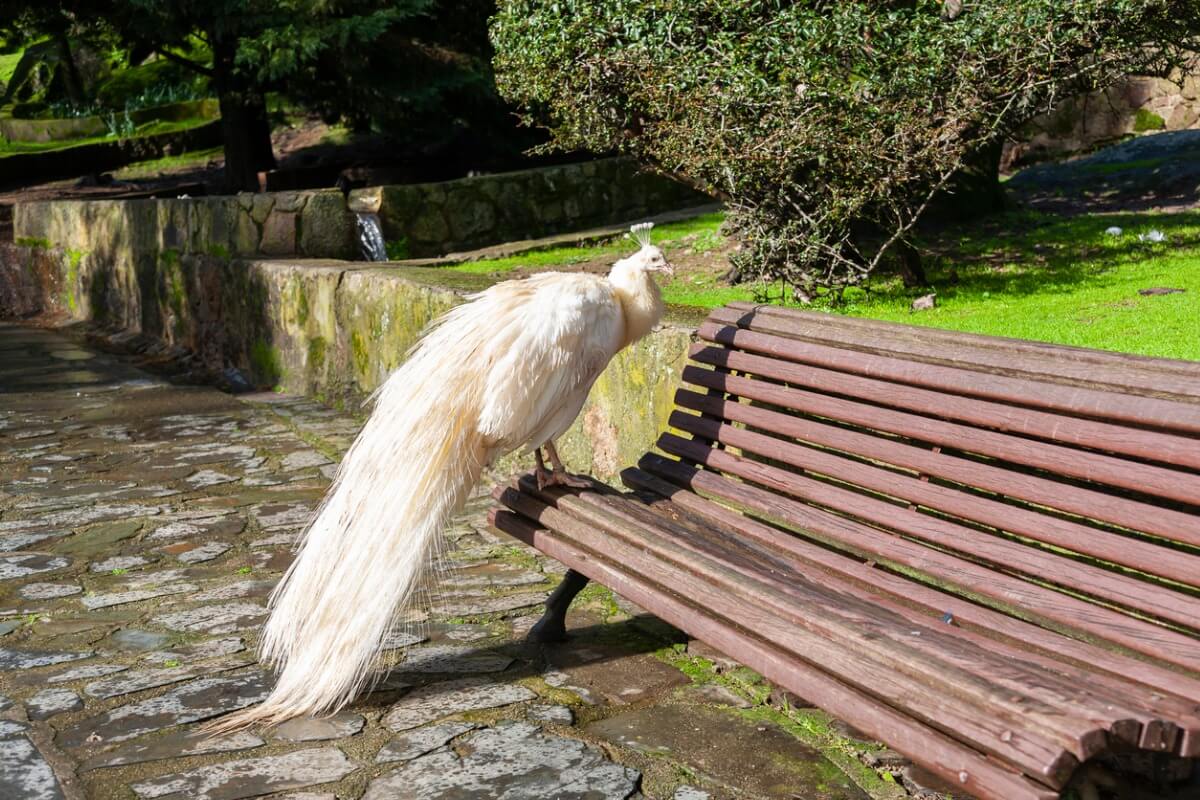The Curious Case of the Albino Peacock

When we see an animal that’s completely white from head to toe, the question arises as to whether it has albinism or another mutation. This is the case with the albino peacock. We can’t always classify an animal as albino simply by the color of its coat or plumage, because, in reality, there are other genetic events that should be taken into account.
Did you know that the albino peacock isn’t a different species of peacock? Its special coloring is due to a genetic variation that has been maintained over time. If you want to know more about this striking mutant trait, please do read on.
Types of species and physical characteristics of the albino peacock
- Indian blue (Pavo cristatus).
- Green peacock from Myanmar, Indochina and Java (Pavo muticus).
- Congo peacock (Afropavo conguensis).
The first two species are located on the Asian continent, while the third is only in Africa. In all of them, their name refers to the regions they can be found in or, failing that, to unique features regarding their plumage.

Characteristics of the albino peacock
However, we’ll be devoting these lines to peacock specimens that have developed albinism. As we’ve observed, all three species can give rise to albino peacock specimens. In addition, not only are they similar for that reason, but they also share characteristics with each other and with the albino specimens. Some of them are the following:
- Explosive tonality: The mutation has resulted in the animal being completely white, except for its eyes. However, the rest of the specimens have strong and iridescent blue and green tones.
- Diet: Being omnivores, albino peacocks feed on plants, insects, or small vertebrates – such as reptiles or amphibians.
- Life expectancy: According to breeders, it has been observed that breeding this species in captivity increases its life expectancy. However, in specimens that suffer from the mutation in nature, their life span is shorter.
- Their song is reminiscent of a feline: When peacocks sing, the sound is quite similar to the meowing of cats. However, this tone can also resemble squawks. It seems that it depends on the moment and the situation. In this way, their songs are used as a call, a cry to their parents, or to express anguish in the face of loneliness.
- Sexual dimorphism: The larger males have a spectacular tail, both in diameter and in its original and striking coloration. Apparently, their main objective is evolutionary, as they seek to attract the attention of females. On the other hand, it should also be noted that the male is called a peacock and the female a peahen. The young are simply called chicks.
Origin and state of conservation
Leucism or albinism?
Although their white hue leads us to think that these birds carry albinism genes, this is not the only cause that we can assess. Although the albino peacock comes from a mutation in which melanin is lost from the body, its white plumage can also be caused by a mutation called leucism.
To differentiate leucism from albinism, one must look at some characteristic patterns. We look mainly at the eyes of the specimens that suffer from one or the other. If the eyes are similar to those of specimens without albinism and retain normal tones, then the animal is leucistic. However, if these are reddish or pink, we’re dealing with an animal with albinism.
Albino morphotype diseases
In addition to changing the characteristic color of the species, the albino peacock is more sensitive to factors that normally affect the species. Thus, exposure to stressors such as excessive humidity or a sudden drop in temperatures can be lethal for an albino specimen, while the normal morphotype (green and blue) could still survive.
Albinism, despite being a beautiful and striking trait, is not without its consequences. Among them, we can list the following:
- Visual deficiency
- Respiratory diseases: among the most severe pathologies, is tuberculosis
- Skin problems
- Low tolerance to strong sun exposure
For all these reasons, the gene isn’t selected in peacock populations. As these mutated specimens have more health problems, they’re less likely to reproduce and, therefore, have fewer offspring than the rest. Thus, natural selection prevents unprofitable traits like this from spreading.

A bird surrounded by spirituality
Animals are part of the cultures of different regions due to certain characteristics that identify them. In the case of the albino peacock, it appears first in the Hindu culture, followed by the Christian one. Within both, it’s identified as a symbol of immortality.
When we see an animal that’s completely white from head to toe, the question arises as to whether it has albinism or another mutation. This is the case with the albino peacock. We can’t always classify an animal as albino simply by the color of its coat or plumage, because, in reality, there are other genetic events that should be taken into account.
Did you know that the albino peacock isn’t a different species of peacock? Its special coloring is due to a genetic variation that has been maintained over time. If you want to know more about this striking mutant trait, please do read on.
Types of species and physical characteristics of the albino peacock
- Indian blue (Pavo cristatus).
- Green peacock from Myanmar, Indochina and Java (Pavo muticus).
- Congo peacock (Afropavo conguensis).
The first two species are located on the Asian continent, while the third is only in Africa. In all of them, their name refers to the regions they can be found in or, failing that, to unique features regarding their plumage.

Characteristics of the albino peacock
However, we’ll be devoting these lines to peacock specimens that have developed albinism. As we’ve observed, all three species can give rise to albino peacock specimens. In addition, not only are they similar for that reason, but they also share characteristics with each other and with the albino specimens. Some of them are the following:
- Explosive tonality: The mutation has resulted in the animal being completely white, except for its eyes. However, the rest of the specimens have strong and iridescent blue and green tones.
- Diet: Being omnivores, albino peacocks feed on plants, insects, or small vertebrates – such as reptiles or amphibians.
- Life expectancy: According to breeders, it has been observed that breeding this species in captivity increases its life expectancy. However, in specimens that suffer from the mutation in nature, their life span is shorter.
- Their song is reminiscent of a feline: When peacocks sing, the sound is quite similar to the meowing of cats. However, this tone can also resemble squawks. It seems that it depends on the moment and the situation. In this way, their songs are used as a call, a cry to their parents, or to express anguish in the face of loneliness.
- Sexual dimorphism: The larger males have a spectacular tail, both in diameter and in its original and striking coloration. Apparently, their main objective is evolutionary, as they seek to attract the attention of females. On the other hand, it should also be noted that the male is called a peacock and the female a peahen. The young are simply called chicks.
Origin and state of conservation
Leucism or albinism?
Although their white hue leads us to think that these birds carry albinism genes, this is not the only cause that we can assess. Although the albino peacock comes from a mutation in which melanin is lost from the body, its white plumage can also be caused by a mutation called leucism.
To differentiate leucism from albinism, one must look at some characteristic patterns. We look mainly at the eyes of the specimens that suffer from one or the other. If the eyes are similar to those of specimens without albinism and retain normal tones, then the animal is leucistic. However, if these are reddish or pink, we’re dealing with an animal with albinism.
Albino morphotype diseases
In addition to changing the characteristic color of the species, the albino peacock is more sensitive to factors that normally affect the species. Thus, exposure to stressors such as excessive humidity or a sudden drop in temperatures can be lethal for an albino specimen, while the normal morphotype (green and blue) could still survive.
Albinism, despite being a beautiful and striking trait, is not without its consequences. Among them, we can list the following:
- Visual deficiency
- Respiratory diseases: among the most severe pathologies, is tuberculosis
- Skin problems
- Low tolerance to strong sun exposure
For all these reasons, the gene isn’t selected in peacock populations. As these mutated specimens have more health problems, they’re less likely to reproduce and, therefore, have fewer offspring than the rest. Thus, natural selection prevents unprofitable traits like this from spreading.

A bird surrounded by spirituality
Animals are part of the cultures of different regions due to certain characteristics that identify them. In the case of the albino peacock, it appears first in the Hindu culture, followed by the Christian one. Within both, it’s identified as a symbol of immortality.
All cited sources were thoroughly reviewed by our team to ensure their quality, reliability, currency, and validity. The bibliography of this article was considered reliable and of academic or scientific accuracy.
- Pavo real. Pavorealpedia.com . Accedido el 1 de mayo de 2021 en: http://www.pavorealpedia.com/
- Pavo real blanco. Criasdeaves.com. Accedido el 1 de mayo de 2021 en: https://criadeaves.com/pavos-domesticos/pavo-real-blanco/
- Pavo real blanco o albino. Hablemosdeaves.com. Accedido el 1 de mayo de 2021 en: https://hablemosdeaves.com/pavo-real-blanco-o-albino/
This text is provided for informational purposes only and does not replace consultation with a professional. If in doubt, consult your specialist.








